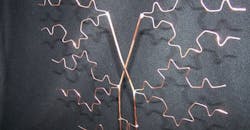Antennas are important components in many systems, although they often add considerable size and weight. In their efforts to shrink the size and weight of RF/microwave antennas for spaceborne applications and wearable electronic devices, researchers from the University of Texas at Austin and Texas State University developed a miniaturized, tree-shaped fractal antenna (FA) on a flexible circuit material. It’s approximately one-half the size of a standard rectangular patch antenna designed for the same frequencies.
The antenna is fabricated on commercial, flexible circuit substrate material using conductive metal (silver) ink and a material inkjet printer capable of producing repeatable features as fine as 20 μm. The V-shaped branches of the antenna’s tree structure, which are unit cells with very repetitive behavior, do not require much space on the substrate material. The antenna is fed by a 50-Ω coplanar-waveguide (CPW) transmission-line section with filleted grounds to reduce the size of the antenna’s metal footprint and increase the antenna’s bandwidth by providing in-phase reflections from ground at more frequencies. Impedance matching to the antenna is performed by a tapered CPW transmission line.
Various iterations of the antenna were simulated, fabricated, and measured with commercial simulation software and test equipment. This was done to better understand the effects of dimensional changes on frequency and how the number of branches in a printed tree structure would impact the assorted frequencies and performance levels of the antennas. Many different resonant frequencies and bandwidths were studied, including a bandwidth of 2.83 GHz at 16 GHz and a bandwidth of 2.05 GHz at 7.71 GHz.
Most antenna configurations resulted in respectable gain at the resonant frequency. In all cases, the tree-shaped FAs were fabricated with significant reduction in metal ink compared to standard rectangular patch antennas, with much smaller metal footprints and smaller antenna sizes. Thus, these antennas make strong candidates for wearable electronic devices throughout the RF/microwave frequency range.
See “A Miniaturized Tree-Shaped Fractal Antenna Printed on a Flexible Substrate,” IEEE Antennas and Propagation Magazine, June 2019, pp. 60-66.
About the Author
Jack Browne
Technical Contributor
Jack Browne, Technical Contributor, has worked in technical publishing for over 30 years. He managed the content and production of three technical journals while at the American Institute of Physics, including Medical Physics and the Journal of Vacuum Science & Technology. He has been a Publisher and Editor for Penton Media, started the firm’s Wireless Symposium & Exhibition trade show in 1993, and currently serves as Technical Contributor for that company's Microwaves & RF magazine. Browne, who holds a BS in Mathematics from City College of New York and BA degrees in English and Philosophy from Fordham University, is a member of the IEEE.

